
Overview
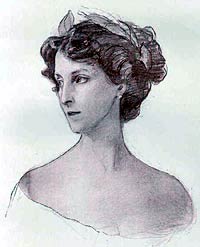 The Duchess of Portland by Philip Alexius de Laszlo (1911)
The Duchess of Portland by Philip Alexius de Laszlo (1911)Born 7 September 1863, Winifred Anna Dallas-Yorke, was the only daughter of Thomas and Francis Dallas-Yorke. She was born at Murthly Castle, Perthshire, the home of her maternal grandmother, Lady Graham, although her parents’ domestic residence was Walmsgate, a hamlet in the civil parish of Burwell, in the East Lindsey district of Lincolnshire. According to an account written by the Duchess of Portland she had the happiest childhood anyone could have. However, newspaper reports suggest that this was not entirely the case and that owing to ‘unfortunate’ differences between her parents she did not have a particularly happy home life.1 Perhaps this is the reason that when she was sixteen her mother took her off to Rome for two winters for her education. Francis was an intelligent and cultural woman and entertained many musicians and painters including, Charles Gounod, the French composer, Rubinstein and Fleischel, the pianists and Lenbach the painter. Winifred looked back on this period of her life with precious remembrance, combining education and contact with intellectual people.
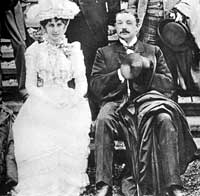 The Duke and Duchess at Walmgate in 1889.
The Duke and Duchess at Walmgate in 1889.She first came to the notice of the 6th Duke of Portland, William John Arthur Charles James Cavendish-Bentinck, who succeeded to the title when his cousin, the 5th Duke of Portland, died without heirs in 1879, when he was travelling north and saw her standing on the platform at Carlisle station. According to the Nottingham Journal the meeting of the Duke and later Duchess was love at first sight and the perfect romance.2 They met again at Belvoir castle, the home of Winifred’s friend, Lady Granby. The 6th Duke was known to be a great catch, having an annual income of £300,000, as well as owning half a dozen castles. So, it was a surprise when he chose Winifred for his bride, putting the noses out of numerous debutantes and their mothers! In March of 1899 the Duke entertained Winifred and her parents at Welbeck, showing them around the estate and he had decided to build a church on the eve of his wedding between Holbeck and Holbeck Woodhouse about one mile from Welbeck.3 The wedding was held at St Peter's Church, Eaton Square, London on Tuesday 11 June 1889, and the couple travelled back to Welbeck, via Worksop, by train.4
Within a year their first baby was born, Lady Victoria Alexandrina Violet Cavendish-Bentinck, on 27 February 1890. The Duchess, however, suffered after the birth and went to recuperate at the family home, Langwell House, Caithness. By September 1890 she had recovered her health and was able to completely fulfil her duties. On 20 February 1891 the Duke visited the Mansfield Hospital to open a new accident hospital, to which he had made a handsome donation. It was with some surprise that the Duchess arrived with her new baby and nurse to be shown around the hospital. She went on to have another two children, both boys.
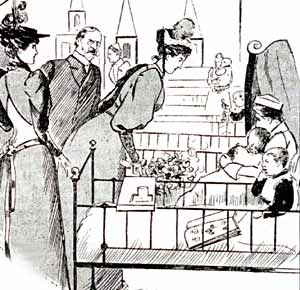 Sketch of the Duchess opening a London childrens' hospital in 1892.
Sketch of the Duchess opening a London childrens' hospital in 1892.Throughout her life the Duchess was a champion for the underdog, both human and animals. The Duchess’s interest in the well-being of others, especially children, had begun with the formation of the Nottingham ‘Cripples’ Guild in October 1907. The prologue to the formation of the Guild was that the attention of a few ladies and gentlemen in Nottingham had been drawn to the condition of some of the ‘cripples’ whom they noticed from time to time around the city. These unfortunates received little or no education. The Mayor, Alderman Green, consented to be the first President and it was around 1908-09 that the Duchess was unanimously elected as president of the Guild, remaining in that position for several decades.
During her first few years as president, she observed the problems of children inflicted with physical impediments and was very concerned and believed that for many they were poorly fed and drank bad milk. She admired the early treatment of children and in over half the cases their handicap could have been prevented.5 As early as 1914 a proposal was made to build a home for those unfortunates in Nottingham and those afflicted by surgical tuberculosis on St James Street, Nottingham. A plan to use Bulwell Hall as a site for an institution for children with physical impediments had to be abandoned because of the war.6 In 1923 new premises situated at 45 Park Row were acquired and on 10 January 1925 the Duchess laid a foundation stone for the Prevention, Aftercare and Training Centre in Park Row.7 So admired for its work in 1926 the Daily Journal bore the headline “Paradise in Park Row!”.8
Throughout her life she worked tirelessly raising funds for the Guild. By the 1920s the Nottingham ‘Cripples’ Guild had grown and other areas including Mansfield and Mansfield Woodhouse now had their own guilds. The Mayor of Mansfield and 100 physically handicapped children from this area were invited on a visit to Welbeck.9 A decade later over 200 of similar children from the same area and including Sutton in Ashfield were entertained by the Duke and Duchess at a party at Welbeck Abbey.10 In 1925, together with Julien Cahn, a clinic was set up in a room at the Public Hall to help physically handicapped children of Hucknall, nearer to their homes.11
In August 1927 a fete was held at Welbeck to raise funds for the Nottingham and District ‘Cripples’ Guild, with over 30,000 attendees. The efforts were to raise funds for a country hospital school for physically handicapped children. The object of the hospital would be to secure prompt and efficient treatment for the patients; secure continuity of treatment in the fresh air; to secure the provision of a school and handicraft education and finally to secure help for the patients when treatment was completed.12 The experience of the work done by the Nottingham ‘Cripples’ Guild out-patients proved there was an urgent need for the provision of a special country hospital.13 The end result was the foundation stone of Harlow Wood hospital being laid on 8 November 1928. However, to get to this point many hurdles had to be overcome. Although the Duke of Portland had given £1000 and the site on his estate on the outskirts of Mansfield, there was a substantial shortfall, despite the Duchess organising a Shilling Fund to help, in the end £30,000 was loaned by Sir Jesse Boot, later Lord Trent, founder of Boots the Chemist. He also allowed his building company to build the hospital without profit.14
Harlow Wood hospital lay in 14 acres of countryside and was officially opened by Duke and Duchess of York, with the Duchess and Duke in attendance on 3 August 1929. The Duchess was President of the Guild until well into the 1930s.
Her concern and involvement in charities concerning children is shown in her interest in the National Society of Prevention of Cruelty to Children. In 1894, not long after her marriage to the Duke, she opened The Jeffie Bainbridge Children's Shelter, where food and shelter was available for waifs and strays. It was erected by Emerson Bainbridge, a well-known philanthropist and Justice of the Peace, in memory of his wife and had been presented to the NSPCC.15 In 1906 she opened a bazaar at the Cutlers Hall, Sheffield, on behalf of the Sheffield District supporters of the charity.16 Other charities connected to the help of children she supported were the Orphanage of Mercy in Kilburn, London, Teachers’ Orphan and Benevolent Fund, and the Royal Institution for Deaf and Dumb, Derby where her husband was the President of the institution.17
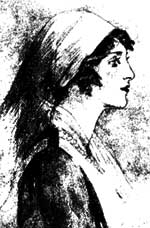 Sketch of the duchess in nurse's uniform in 1917.
Sketch of the duchess in nurse's uniform in 1917.Winifred was involved in the Red Cross during the First World War and in August 1914 at the very beginning of the war, both she and her husband presided over the Annual Display of Red Cross work held at Welbeck Abbey. Some years later, the Duchess and Duke visited the Nottingham General Hospital to speak to newly arrived wounded soldiers from Nijmegen. The Duchess was dressed in the uniform of the British Red Cross. In 1946 after the end of the Second World War, the Duchess, who was now in her eighties, continued to be involved in helping others and opened Ruddington Hall as a peacetime convalescent home for the Nottingham General Hospital. The Duchess was the chairman of the convalescent sub-committee and deputy president of the British Red Cross Society.18
There are many newspaper reports of the Duchess being involved in helping others, including giving money to pensioners and Christmas gifts to those living on or around the Welbeck Estate, at Christmas time.19 Both the Duke and Duchess took a keen interest in the mining community which surrounded their estate. The Duke is quoted as saying, “My wife and I look upon everybody in the district, especially the miners, as our friends.” This was when the Duke and Duchess were granted the freedom of the Borough of Worksop for the work they had done in the surrounding district.20 After an explosion at the Bilsthorpe Colliery the Duchess visited Mansfield Hospital to personally enquire after the victims.21 The Nottinghamshire Miners sent a petition to the King in his Jubilee year, to highlight the Duchess’s work, for which she received the honour of Dame of the British Empire.22
Her interest and concern for children was shown in her keen and practical interest in the work of the school clinics in the Mansfield District. Her visit in January 1923 to the Pleasley Clinic, where 80 mothers were in attendance was warmly welcomed by those mothers.23
They were also personally thanked by Ernest Bevin, Minister of Labour for the work they did during the high unemployment era.24
The Duchess also had a strong interest in the welfare of birds, and in 1891 became the first, and longest-serving, president of the Society for the Protection of Birds - a position which she held until her death and in which she helped the society obtain its royal charter. The Yorkshire Post and Leeds Intelligence as late as 1930, reported on her attending the AGM of the RSPB, where Lord Desborough spoke about his bird sanctuary on his land.25 This was in contrast to her husband who held regular shooting parties both at Welbeck and his Scottish estates. However, he did later admit that he was ashamed at the number of pheasants that were killed on his estates.26
She was also active on behalf of the Royal Society for the Prevention of Cruelty to Animals, serving as vice-president and president of the ladies' committee. In 1920 she visited Ypres cattle show to see some of the young cattle that had been presented by British young farmers to Belgium. She visited York market on behalf of the RSPCA in March 1931. In 1939 the RSPCA awarded two silver medals to the Duke and Duchess on their Golden Wedding Anniversary in recognition of their long and devoted service to animal welfare. The Duchess was the president of the Nottinghamshire branch of the RSPCA and also the president of the Scottish SPCA.
After 40 years of marriage the Duke he was quoted as saying “..she was the Queen of my heart” and went on to say that the Duchess’s work for the relief of sickness and suffering not only included human beings but also dumb animals, beasts and birds.27
The Duchess rarely ate meat, preferring fish and vegetables – spartan fare according to the newspaper – but this was probably the secret of her still perfect complexion.28
The Duchess, alongside her husband, were regular visitors to and from royalty. The Duke and Duchess accompanied the King and Queen at Ascot and they also stayed with Portlands at Welbeck.29 The 6th Duke was Lord Lieutenant of the county for many years and in that position was responsible for meeting, greeting and entertaining royalty. One of those occasions was when King George V and Queen Mary opened the Trent Building in 1928. The couple also entertained foreign royalty including the Shah of Persia and King Leopold of Belgium.30 Nevertheless, both the Duke and Duchess had their feet firmly on the ground and did whatever they could to help their neighbours and were generally liked and welcomed wherever they went. They had a long and happy marriage and celebrated their Golden Wedding in 1939.
Surprisingly there is a road named after the Duchess’s maiden name in Beeston, Dallas-Yorke Road, but the connection is not known.
References
1. Weekly Telegraph 13 November 1899. National Newspaper Archives.
2. Nottingham Journal 1 June 1939.
3. The Sportsman 11 March 1889.
4. Sheffield Independent, 11 June 1899.
5. Nottinghamshire Archives. DD1417/8/1 5th Annual Report of the Nottingham Cripples Guild. Daily Guardian 23 December 1917. Nottingham Journal 1924.
6. Nottinghamshire Archives DD/1417/11/1 Nottingham District Cripples Guild – press cuttings
7. Nottinghamshire Archives DD 1417/11/1 Nottingham District Cripples Guild – press cuttings Nottingham Guardian 9 January 1925
8. Daily Journal 11 February 1926
9. Nottingham Journal 16 September 1926.
10. Nottingham Journal 13 August 1936.
11. Beeston Gazette, 7 November 1925.
12. Nottingham Journal, 2 August 1927 and Sheffield Daily Telegraph 8 November 1928
13. Nottingham Guardian 2 March 1927
14. Nottingham University manuscripts Ga H/57/3
15. Sheffield History and Sheffield Evening Telegraph, 28 December 1894
16. Sheffield Evening Telegraph, 25 October 1906
17. Mansfield Reporter, 19 June 1891, see http://www.childrenshomes.org.uk/KilburnMercy/ accessed 24 October 2021; Sheffield Daily Telegraph 30 October 1903; Stamford Mercury 23 July 1909
18. Nottingham Journal, 23 May 1946
19. Nottingham Journal, 27 January 1927, 27 December 1929, 27 December 1930, 23 January 1931, 23 December 1932 and 19 December 1941
20. Nottingham Journal 14 June 1939
21. Nottingham Journal 2 August 1934
22. The Scotsman, 12 August 1935
23. Mansfield Reporter, 12 January 1923
24. Nottingham Journal, 19 June 1936
25. Yorkshire Post and Leeds Intelligence,13 March 1930.
26. Men, women and things. Memories of the Duke of Portland. Faber and Faber , London. 1939
27. Nottingham University manuscripts Ga H/57/3
28. Nottingham Journal 10 September 1920
29. Nottingham Journal, 12 December 1891; 17 June 1913; 15 February 1928
30. Sheffield Daily Telegraph, 3 July 1889 and Nottingham Journal, 6 December 1937.
Archival
The archives of the Dukes of Portland are held at Nottingham University Manuscripts Department and Nottinghamshire Archives. Although there is a lot of material much of it is concerning correspondence between the Duchess and other people and there are newspaper cuttings but little on her charities.
Printed material
No biography of the Duchess has been published. However, a short piece on her early years and her involvement in the foundation of Harlow Wood Orthopaedic Hospital was written by the Duchess and appears in the Duke's book, Men, Women and Things (pp46-50).
Graphic
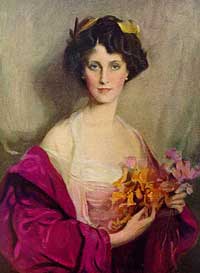 The Duchess of Portland by Philip Alexius de Laszlo (1912)
The Duchess of Portland by Philip Alexius de Laszlo (1912)Several formal portraits of the Duchess were made, one of the most famous being by Philip Alexius de Laszlo. Some of the portraits were reproduced in Society magazines such as The Tatler.
The National Portrait Gallery collection holds 15 images of her.
The Inspire Picture Archive has four photographs of the Duchess attending events in Mansfield.